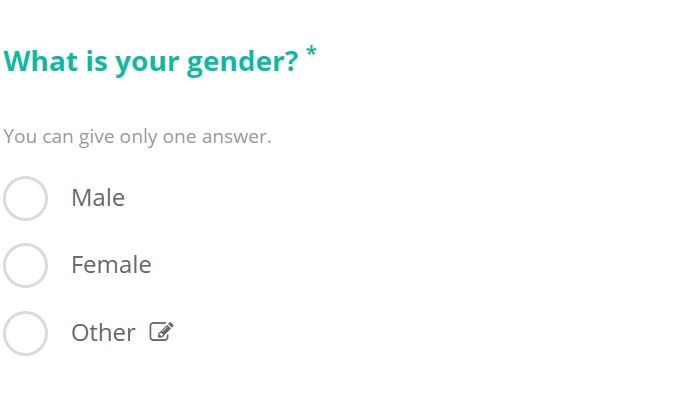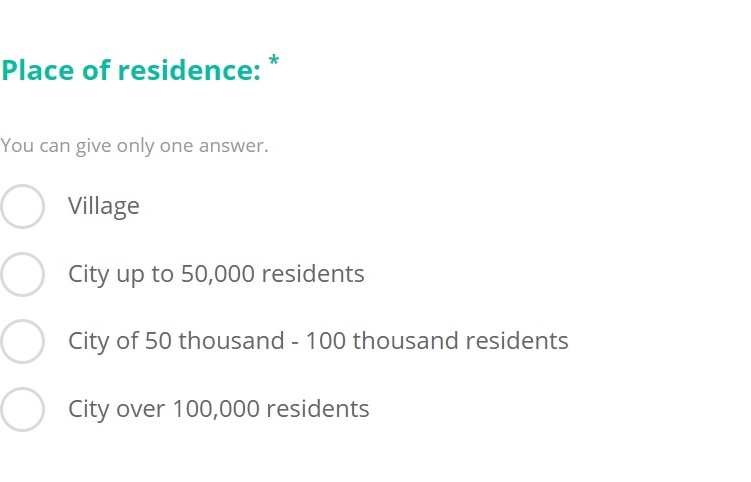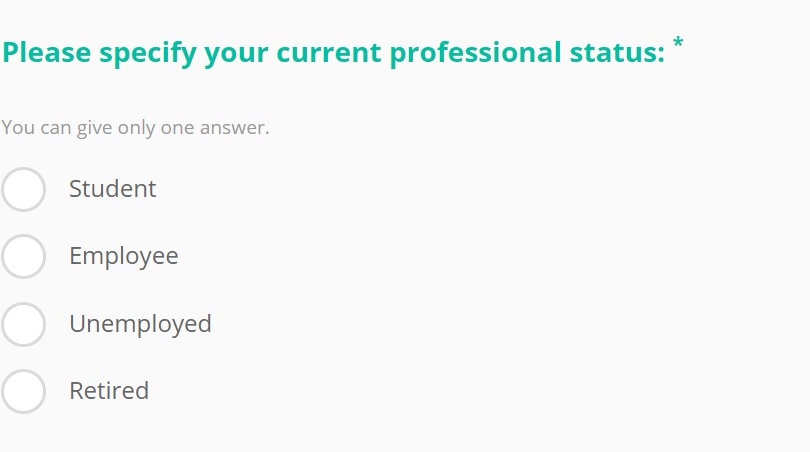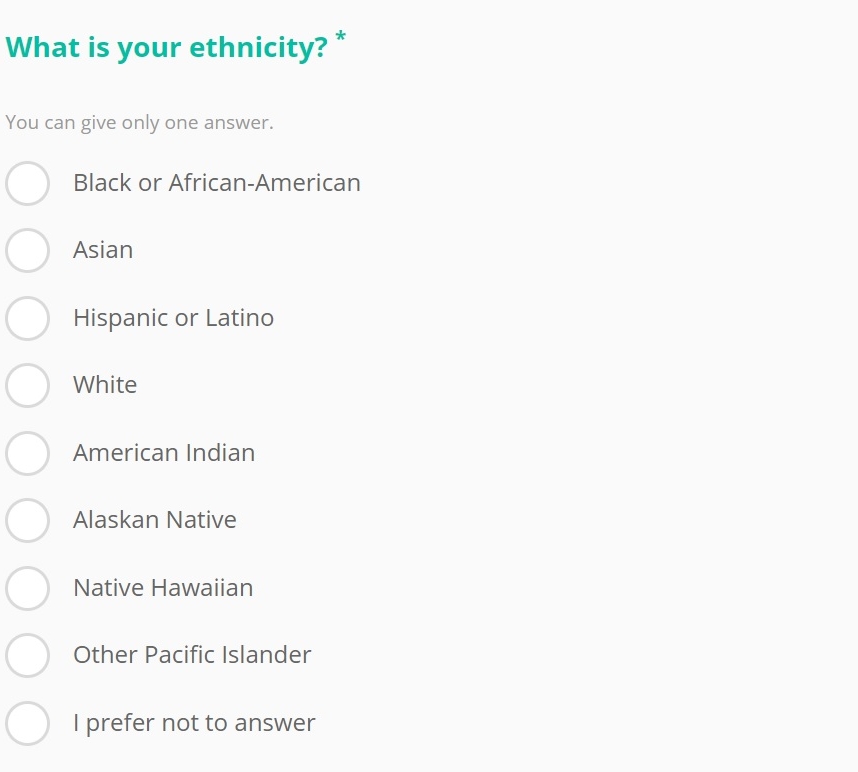

Example question about the age of respondents.
Another very sensitive question but an important one in terms of market research. Again, we ask for gender in the survey to adjust our offer for the client’s needs and create campaigns that matter for survey participants.
Be careful with this demographic question. Ten-twenty years ago we could type “sex” instead of “gender” and provide respondents with two answer options. Nowadays such biological distinction may be offensive. You don’t want that in your own survey. Pay attention to respondents’ comfort and give them a wide range of possible answers.
Some of them may prefer not to answer such a demographic question (just like the one about sexual orientation). Respect that to give yourself a chance for better survey results.

Example question about gender.
Statistically speaking, this is one of the most important questions concerning the population’s characteristics. Does your typical client have a master’s degree? Or maybe most of the survey takers are blue-collar workers or uneducated 30-year-old males with the highest degree of laziness, still living with their parents?
That’s a difference, that might tell you a lot about their disposable income, moral values, primary language, employment status, market research needs, and provide you with other specific demographic data.
Insights about education completed are also a decisive factor regarding the next demographic questions you are going to ask in your questionnaire. Professional survey software, like Startquestion, enables its users to ask different survey questions, depending on previously provided answers.
How to ask education level questions in a survey? Remember to provide all possible answer options. It’s not as controversial as questions about gender or age, so the box “prefer not to say” probably wouldn’t be necessary.
You may always provide it as an answer option.

Example question about education level.
Why should we bother with location survey questions?
If you are running an international business, you may find out that you have clients in specific countries. Each of them has its own culture and communication differences. The better you know them, the better you’ll address your offer to the given market.
Such demographic survey questions may also give you a hint about where your potential international audience occupies.
Another reason relates to local customers. Suppose you have a restaurant with a delivery option only in your town. You may change that and adjust your rules when realizing that you have a significant group of potential clients just a couple of miles away from town borders.

Example question about location.
The participant’s employment status is meaningful demographic data.
Survey questions regarding the role, experience, industry, organization type, or brand may provide marketers with plenty of information, highly desired for targeting purposes. However, we should be careful with any employment status survey question.
I prefer not to say how much I earn. What about you?
It’s a sensitive matter. Of course, it would be great to know the annual household income of survey respondents, but they may not want to share this information with anyone. Be smart. Don’t ask directly for the participant’s income. Do some workaround, asking more safe questions that will give you hints about the respondent’s salary.
Try to be polite and make each survey taker feel comfortable. Bare in mind that you will send the same demographic survey to both employed and unemployed respondents.

Example question about employment status.
Yet another impactful demographic question is about family and place of living. Marketers would love to understand not only the household income level of each customer but also where they live and how many children they have.
Why it’s so important? Because such demographic surveys can provide you with knowledge about respondents’ ability and willingness to spend money on your products or services. If you run a toy shop, you’d probably like to know that your statistical client has children.
Again, asking directly about household income may be unpolite, so try to figure out how to collect the data you need differently. For instance, by asking how many dependents the survey respondent has or similar household size survey question.

Question about household size.
Depending on a survey topic, you may want to ask about marital status. Even though it’s tempting, asking about marital status is also a sensitive demographic survey question. Some respondents may prefer not to say a lot about their private life.
However, the relationship status survey question is a source of data about customers’ habits and everyday spending. Married people buy a different range of products than singles. Understand their priorities to craft the best offer.

Example question about marital status.
Speaking about the problematic demographic survey questions to ask. The last example I’m going to mention is related to ethnicity. Try to ask it only when it’s really significant, and you can’t go without it.
When to ask about race? In multinational countries. Or when you do a global survey. Remember about the “prefer not to say” box and the possibility to provide an answer by respondents on their own.
Be delicate, and, again, ask that demographic question only if necessary.

Example question about ethnicity.
A demographic survey must first and foremost be a good questionnaire.
We already know what and why we want to ask our respondents. Now let me show you the main principles that survey authors should follow to make their questionnaires user-friendly.

Author: Dariusz Jaroń
Updated: 18 November 2022
Content marketing specialist and author of non-fiction books with many years of experience in B2B writing, journalism, and translations. Beginner marathon runner and intermediate mountain hiker. When he isn't writing or jogging, he's probably trying to learn Italian.

With Startquestion, collecting this data is effortless, and our specialists can help implement the receipt surveys in your company.

A successful closed-loop system enhances the customer experience, drives innovation, strengthens brand loyalty, and boosts the bottom line. Learn how to harness the power of feedback, close the loop, and unlock your business's full potential.

Understanding your customers' experiences can elevate your business from good to great. Customer journey mapping, a powerful visual tool, uncovers every interaction customers have with your brand, highlighting pain points and opportunities for improvement.
Quality and safety guarantee:

This site is secured by reCAPTCHA and Google. Valid Privacy Policy and Terms of Service.
Manage cookieGet Feedback Racino Sadowski Skowronek s.j. as the Personal Data Controller, processes your personal data using cookies to ensure the proper functioning of the website. You can manage your preferences by selecting the appropriate button by clicking "Accept all cookies" or "Decline cookies” or “Manage your cookies”. You can withdraw your consent at any time by changing the selected settings. More information about the use of cookies and the processing of your personal data, including your rights, can be found in our Privacy Policy.
Functional Functional Always activeStorage of or access to technical data is strictly necessary for the legitimate purpose of enabling the use of a specific service expressly requested by the subscriber or user, or for the sole purpose of carrying out the transmission of a message over an electronic communications network.
Preferences PreferencesStorage or technical access is necessary for the legitimate purpose of storing preferences that are not requested by the subscriber or user.
Statistics StatisticsTechnical storage or access that is used exclusively for statistical purposes. Technical storage or access that is used solely for anonymous statistical purposes. Without a subpoena, voluntary compliance from the ISP, or additional records from a third party, information stored or retrieved solely for this purpose usually cannot be used to identify you.
Marketing MarketingStorage or technical access is required to create user profiles for the purpose of sending advertisements or tracking a user on a website or on several websites for similar marketing purposes.